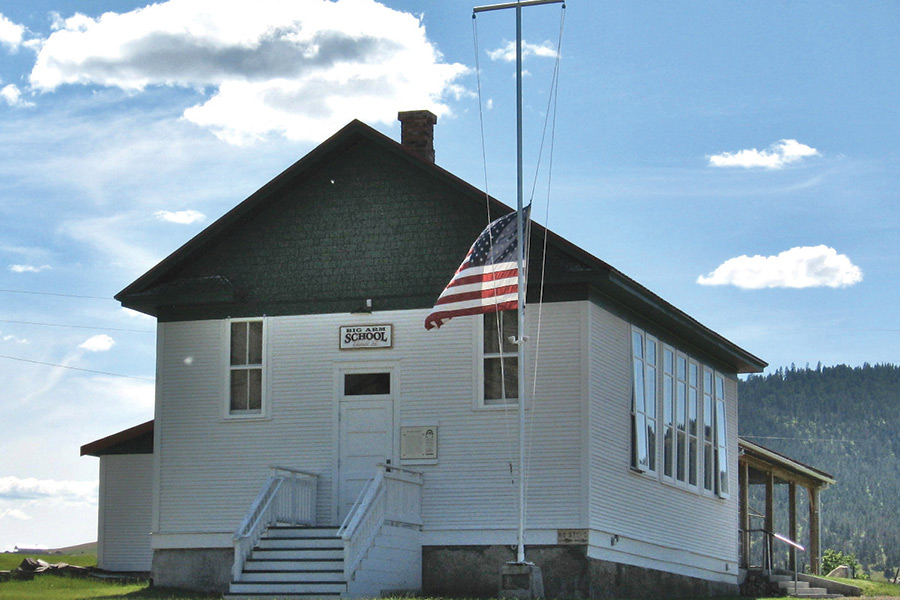“One room, two outhouses”: This can describe many one-room schoolhouses that once dotted the Montana landscape, including the Big Arm Schoolhouse.
In 1910, the Flathead Indian Reservation was opened to non-natives for settlement, causing a “land rush.” Consequently, Big Arm, Dayton and other townsites seemingly grew overnight. And so did the need for infrastructure, services and schools where the settlers’ children could learn (when not tending to their farming or ranching chores).
Initially, native children and non-native children were segregated. But when the Big Arm Schoolhouse opened in 1917, Native American children and the settlers’ children were taught in the same school, by the same teacher, in the same single room. The Big Arm Schoolhouse became a place where lessons were learned, childhood memories were made and adults gathered to debate or vote after school.
Although words of wisdom have since passed, the Big Arm Schoolhouse retains much of its original character and still “recites” many ideals of one-room schoolhouse design. For example, the front entrance stairs are still in the same place (where children “walked up toward enlightenment” and “looked up” to their teacher at the top of the stairs).
The windows along the north side also remain intact – while the windows along the south side remain noticeably absent. At the time, sunlight from opposing directions was considered harmful to the students’ eyes and a distraction to their learning, so windows were only installed on the less-glaring north side (mind you, electric lighting wasn’t installed until the 1940s).
The cloakroom area that flanked the entranceway remains, although most of the hardware has been removed. And the original wood floor – upon which students walked their homework to the front of the class – still hold their original place.
The two original outhouses (one for boys and one for girls), still stand at the edge of the schoolyard where the teacher could keep a watchful eye from the windows. And the chimney at the center of the schoolhouse quietly explains how children kept warm and heated their soup-jar lunches.
Perhaps more difficult to see today, the schoolhouse stood at the edge of the once-busy town of Big Arm. When the school was built, Big Arm (originally named “Bigarm”) could boast of its share of shops and services, such as the Big Arm Mercantile, a horse racing track and the Big Arm Graphic newspaper, which told of the goings-on about town and the surrounding area.
Incidentally, the Big Arm Graphic reported the progress of the “Polson – Big Arm Road,” which was being graded and improved as the schoolhouse was being built. Coincidentally, the road would later cause the demise of the schoolhouse.
Generations of students graduated from the school until 1952, when the sole teacher at the school asked for a pay raise. The Polson School District figured it was less expensive to bus students to Polson, so the Big Arm Schoolhouse was closed down.
The schoolhouse still served as a community hall sporadically until it was shuttered in 1995. Fortunately, the Big Arm Association volunteers began much-needed preservation work on the schoolhouse in 2007. And thanks to their efforts, the Big Arm Schoolhouse was added to the National Register of Historic Places and re-opened for community use.
If you’d like to learn more about the schoolhouse and see it for yourself, the Big Arm Association is hosting a yard sale and breakfast on July 26. Call (406) 849-5064 for details.
Jaix Chaix appreciates history and architecture. You can share ideas and facts with him at [email protected] or at
facebook.com/flatheadvalleylandmarks.
